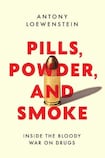
In 1971, Richard Nixon declared drug abuse “public enemy number one”, inaugurating what quickly became known as the “war on drugs”. But the real target, one of his advisers, John Ehrlichman, said later, was not drugs, but blacks and hippies.
Ehrlichman was one of the Watergate conspirators, for which he served 18 months in prison. In 1994 he told journalist Dan Baum the drugs war had been designed to undermine opposition to Nixon.
Nixon “had two enemies: the anti-war left and black people”, Ehrlichman said. “We knew we couldn’t make it illegal to be either against the war or black, but by getting the public to associate the hippies with marijuana and blacks with heroin, and then criminalising both heavily, we could disrupt those communities. We could arrest their leaders, raid their homes, break up their meetings, and vilify them night after night on the evening news. Did we know we were lying about the drugs? Of course we did.”
In Pills, Powder and Smoke, a survey of the troubled history and troubling present of the international war on drugs, journalist Antony Loewenstein advances a dual thesis – this war has been a colossal failure; and this failure was the inevitable, or even intentional, result of a strategy that was never about defeating drug trafficking, but was instead about protecting other US interests.
On the one hand, writes Loewenstein, the war on drugs is a real war, recklessly prosecuted, in which innocent and vulnerable people are collateral damage, and which, after half a century, has only made the drugs problem worse.
On the other hand, it is also “a phoney war pushed by the US to control segments of its own population, manage client states near and far, enrich the US defence industry, and benefit close allies” in what amounts to “a form of neo-imperialism”.
The first part of this thesis appears irrefutable, and Loewenstein marshals the evidence well, from the data to the history to on-the-ground reportage. In the UK in 2018, for example, after “45 years of the harshest drugs policies in Europe”, there were “more drug deaths per head than [in] any other country in Europe”.
In Honduras, he relates how the “seeds of today’s drug war” were planted during the Contra war in neighbouring Nicaragua, when the US, via the CIA, backed the Contra rebels in their bid to overthrow the Sandinista regime, and the CIA duly turned a blind eye to drug trafficking by the Contras.
In the Philippines, Loewenstein visits the dystopian Manila district of Binondo, and finds an area plagued by poverty, drug abuse and horrendous violence, which an informant tells him has taken 1,000 lives since Rodrigo Duterte won the presidency in 2016 and unleashed his uniquely extravagant version of the war on drugs.
Political opportunism
That these various wars on drugs are more about political opportunism and “tough on crime” conservatism than about evidence-led policy is not a surprise– I would have thought this was close to the consensus amongst left/liberal/centrist policy makers and commentators. In the past six months alone, for example, the New York Times has run opinion pieces headlined “The Latest Failure in the War on Drugs”, “Seattle Has Figured Out How to End the War on Drugs” and “The Christian Case for Marijuana”.
As for the second part of Loewenstein’s thesis, the strongest evidence he produces that the war on drugs is a “phoney war” is that quote – albeit a devastating one – obtained by Dan Baum 25 years ago in a fleeting interview with a discredited former Nixon adviser.
The US has long seen various countries of Latin America, at various times, as “client states”; the drugs war has provided one means of funnelling money to compliant governments. The defence industry has also benefited from the war. But that does not mean the war was designed to those ends, and Loewenstein does not produce the evidence to prove it was.
Loewenstein appears to be confusing the effects (or side effects) of policy with the intent of policy. As should be clear from the current impeachment saga, identifying what US foreign policy is and who is responsible for it is notoriously difficult – even the foreign policy establishment is divided. Is foreign policy what the president says it is? Or is it what the “deep state” is pursuing?
But even this latter question rests on a fallacy. There is no single “deep state” – there is a vast mosaic of interests and agendas, deeply embedded in different corners of the state, which form shifting coalitions and rivalries on different issues. A simplistic left-wing critique that attributes the most malign motivation to an entire system is self-defeating, because it undermines the ability of critics to work with agents of that system to achieve reform.
Amidst the polemic, there is much vivid reportage. In Guinea-Bissau, Loewenstein visits the national radio centre, and finds “a room filled with decaying audio-tapes; the country’s history was withering away. There was no money to maintain this invaluable archive, and the country’s recorded history was disappearing”. In Quezon City in the Philippines, he spends a night with the “nightcrawlers”, photojournalists who chase the corpses produced by the city’s violence. Closer to home, he paints a grim portrait of Newcastle in England, in parts of which more than half of children are growing up in poverty, and where he finds an image of the city in a desolate shopping centre with filthy windows and urine puddled in the elevator.
Supporters of the drug war will ask, what’s the alternative? It is a shame that Loewenstein doesn’t visit Portugal, though he does cite it. Portugal decriminalised drugs in 2001; it has since seen the number of heroin users collapse and now has the lowest drug-related death rate in Western Europe. In Amsterdam, though, the ready availability of soft drugs and sex has created an “urban jungle”, he writes, comprising “criminal activity, human trafficking, Moroccan gangs running the ecstasy market, and dirty streets”, resulting in Dutch police warning in 2018 that the country risked turning into a “narco-state”.
So even if the drug war has been a disaster, it is not clear precisely what an alternative policy looks like, or how it should be rolled out. Loewenstein does some good work sketching elements of it, and elaborates some ideas in a penultimate chapter titled “Solutions”, but they lack the eye-witness acuity and rigorous scepticism he brings to the drug war itself. That, perhaps, could be his next book.








